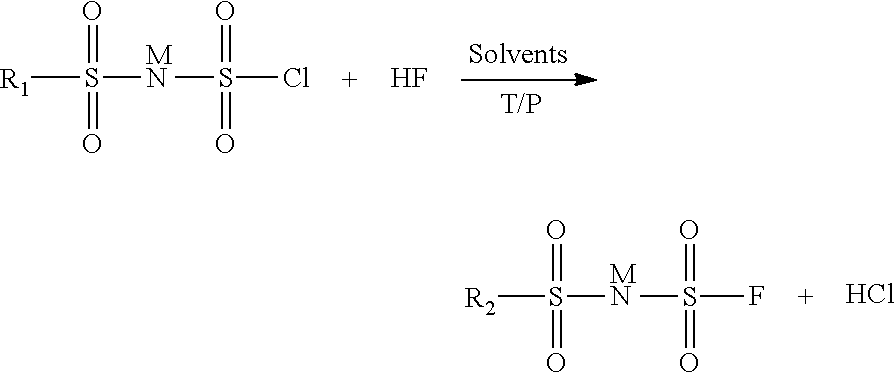Method for preparing imide salts containing a fluorosulphonyl group
a technology of fluorosulphonyl group and imide salt, which is applied in the field of fluorination process, can solve the problems of limited thermal stability, low cost of synthesis, and instability of hydrolysis
- Summary
- Abstract
- Description
- Claims
- Application Information
AI Technical Summary
Benefits of technology
Problems solved by technology
Method used
Image
Examples
example 1
[0030]In an 800 ml autoclave, 28 g of (ClSO2)2NH are dissolved in 50 ml of acetonitrile. 10 g of HF are then added. The pressure is then 0.34 bar absolute and the temperature is maintained at 10° C. The reaction is left to stir in a closed medium for 18 h. The excess HF is removed by pumping. The reaction medium is then treated with lithium carbonate. The solution is filtered and then evaporated and the residue is analyzed by 19F NMR. The analysis shows the presence of 85% of totally fluorinated product (FSO2)2NLi, 7.5% of FSO3Li and 7.5% of FSO2NH2. The latter two are the compounds formed during the degradation of the starting product.
example 2
[0031]In an 800 ml autoclave, 31.7 g of (ClSO2)2NH are dissolved in 50 ml of acetonitrile. 10 g of HF are then added. The pressure is then 0.75 bar absolute and the temperature is maintained at 20° C. The reaction is left to stir in a closed medium for 18 h. The excess HF is removed by pumping. The reaction medium is then treated with lithium carbonate. The solution is filtered and then evaporated and the residue is analyzed by 19F NMR. The analysis shows the presence of 100% of totally fluorinated product (FSO2)2NLi and the absence of the degradation products FSO3Li and FSO2NH2.
example 3
[0032]In an 800 ml autoclave, 61 g of (ClSO2)2NH are dissolved in 50 ml of 1,4-dioxane. 20 g of HF are then added. The pressure is then 2.3 bar absolute and the temperature is maintained at 25° C. The reaction is left to stir in a closed medium for 18 h. The excess HF is removed by pumping. The reaction medium is then treated with lithium carbonate. The solution is filtered and then evaporated and the residue is analyzed by 19F NMR. The analysis shows the presence of 100% of totally fluorinated product (FSO2)2NLi and the absence of the degradation products FSO3Li and FSO2NH2.
PUM
| Property | Measurement | Unit |
|---|---|---|
| donor number | aaaaa | aaaaa |
| donor number | aaaaa | aaaaa |
| boiling point | aaaaa | aaaaa |
Abstract
Description
Claims
Application Information
 Login to View More
Login to View More - R&D
- Intellectual Property
- Life Sciences
- Materials
- Tech Scout
- Unparalleled Data Quality
- Higher Quality Content
- 60% Fewer Hallucinations
Browse by: Latest US Patents, China's latest patents, Technical Efficacy Thesaurus, Application Domain, Technology Topic, Popular Technical Reports.
© 2025 PatSnap. All rights reserved.Legal|Privacy policy|Modern Slavery Act Transparency Statement|Sitemap|About US| Contact US: help@patsnap.com


